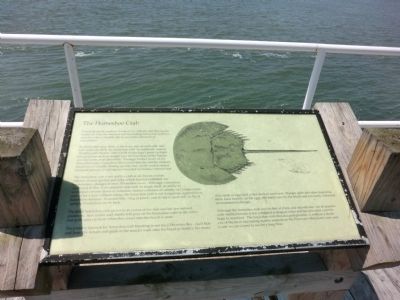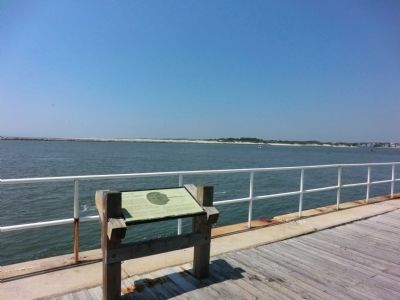Ocean City in Worcester County, Maryland — The American Northeast (Mid-Atlantic)
The Horseshoe Crab
Boasting nine eyes, three in the front, one on each side, and four under its shell, the horseshoe crab scientifically named “limulus polyphemis” after Greek mythology’s great Cyclops, has given researchers insight into the functions of the human eye and some of its disorders. Through further study of the horseshoe crab, researchers discovered that the marine animal’s blood has a valuable clotting quality that can be used to detect bacterial poisons in substances intended for human internal use.
The horseshoe crab is not really a crab at all, but an ancient relative of land spiders and ticks, which has not exhibited and evolutionary changes in over 350 million years. Although sometimes compared to that of an armored tank with its tough shell, its ability to withstand extreme doses of radiation, endure extremes of salinity and temperature, and go for a year without eating, the horseshoe crab is not dangerous, aggressive or harmful to humans. It cannot bite, sting or pinch, and its tail is used only to flip it upright if somehow on its back.
The adult horseshoe crab grows to an excess of two feet and has few natural predators. Sea turtles and sharks will prey on the horseshoe crab in the water, and gulls prey on them when they crawl onto the beach to mate.
The primary location for horseshoe crab breeding is our local Delaware Bay. Each May and June the female crab pulls in the smaller male onto the beach to fertilize her many thousands of eggs laid in her shallow sand nest. Hungry gulls and other migrating birds feast heartily on the eggs, but many survive the attack and can easily withstand environmental changes.
Although the horseshoe crab and its diet of clams and mussels may not be popular with shellfisherman, it has exhibited ecological value and has provided scientific hope to mankind. The horseshoe crab (limulus polyphemis), is without a doubt one of the most fascinating marine animals on the Delaware/Maryland coast, and is one we can expect to see for a long time.
Topics. This historical marker is listed in this topic list: Animals.
Location. 38° 19.517′ N, 75° 5.333′ W. Marker is in Ocean City, Maryland, in Worcester County. Marker is on South 2nd Street. The marker overlooks the Ocean City Inlet. Touch for map. Marker is in this post office area: Ocean City MD 21842, United States of America. Touch for directions.
Other nearby markers. At least 8 other markers are within walking distance of this marker. Trail of the Whispering Giants (here, next to this marker); Native Americans (a few steps from this marker); The Blue Crab (within shouting distance of this marker); Birds of the Shore (within shouting distance of this marker); Shore Camping / Island Exploring (within shouting distance of this marker); Island on the Move (within shouting distance of this marker); Largest Fish (within shouting distance of this marker); British Manufactured Cannon (about 300 feet away, measured in a direct line). Touch for a list and map of all markers in Ocean City.
Credits. This page was last revised on June 16, 2016. It was originally submitted on July 7, 2013, by Don Morfe of Baltimore, Maryland. This page has been viewed 372 times since then and 7 times this year. Photos: 1, 2. submitted on July 7, 2013, by Don Morfe of Baltimore, Maryland. • Bill Pfingsten was the editor who published this page.

